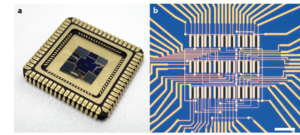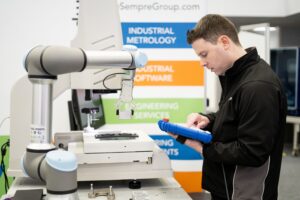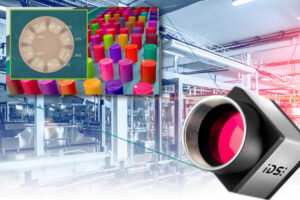MB Dynamics, field-proven industry experts in the design, manufacture and supply of vibration test systems and equipment, including buzz, squeak and rattle (BSR), steering, and suspension component test systems; modal exciters and amplifiers; single- and multi-DUT automated accelerometer calibration systems; dynamic controllers; transducer calibration systems; and test engineering services, has announced the 1300th successful field installation of its Modal 50A exciter. With this milestone, the Modal 50A has now become MB Dynamics’ best-selling modal exciter worldwide.
The Modal 50A exciter was 100% designed and developed at the company’s own Cleveland, Ohio, U.S.A.-based global corporate headquarters and R&D centre, by an in-house engineering team that is comprised of multiple 40-year global experts in modal testing. Several team members were also formerly professors at the famed University of Cincinnati Structural Dynamics Research Laboratory.
Key R&D goals for the MB Dynamics Modal 50A exciter centred around addressing the most common problems associated with the use of traditional shakers in modal testing. At the time of initial Modal 50A design, most industry modal exciters lacked portability; had complex setup and installation requirements; and exhibited certain operational accuracy deficiencies. The Modal 50A exciter therefore needed the necessary reliability and performance for support of a diverse array of modal and structural testing requirements, ranging from smaller test articles up thru mid- to full-size automobiles. MB Dynamics aimed to accomplish this versatility, while still ensuring a modal exciter which could reliably deliver 50 pounds of dynamic force.
The 1” pk-pk continuous stroke (optional 30 mm pk-pk) of the Modal 50A exciter, with 1.1” between stops, offers reliable and sufficient excitation for both flexible structures and low-frequency “suspended shaker” tests. Its lightweight (less than 0.33 lbs.) armature provides a reliable excitation source for the modal testing of small articles with minimised mass loading. A unique armature design allows for important and dramatic reductions in force drop-off at test article resonances. In addition, the Modal 50A’s broad usable frequency range, from DC to 5000 Hz, allows it to accommodate virtually any modal survey type, including multi-shaker random, single-point random, multi-point sine dwell, and burst random.
The relatively compact (11.5” x 7.5” x 9.25”) and lightweight (55 pounds inclusive of trunnion base) footprint of the Modal 50A facilitates its ease of installation within space constrained environments. The exciter, its easy-mount inertial masses, and related accessories may be easily setup and operated by a single person, including in remote locations. The trunnion base of the Modal 50A incorporates two unique hand-knobs and three screw feet, allowing for exciter adjustments to be performed at virtually any excitation angle. A quick connect/disconnect feature for additional masses is also used to provide large inertial restraint during low-frequency modal testing, while a series of quick disconnect turnbuckles allow for both adjustable suspension and ease of 6DoF positioning. Low armature axial suspension stiffness (<15 lbs./in) further ensures that Modal 50A exciter dynamics may be decoupled from the test specimen. The exciter can also drive cable lengths ranging from 30 to 100 (optional) feet.
The process of attaching the Modal 50A exciter to a test structure is simplified via streamlined onboard fixturing. This includes a centre bore clearance hole which extends through the armature, housing, trunnion base and inertial masses, and which allows for unlimited shaker positioning along the stinger axis. A collet chuck allows for the gripping of either a “one size fits all” threadless stinger or a “piano wire” stinger, in sizes from 0.020″ to 0.12″ (0.5 to 3.0 mm). Use of the “piano wire” stinger decouples force inputs in all directions except for that of the driven axis, thereby avoiding cross-axis force measurement errors. An oscillatory force of 50 pounds keeps required preloaded tension to the stinger, thereby eliminating buckling problems, while still delivering exciter peak dynamic force. These and other combined features allow the Modal 50A exciter to provide superior forcing functions, along with the virtual elimination of common measurement errors associated with bending moments, side loads, and end-user reliance on traditional stinger compression loading functionality.
Recommended optional accessories for the Modal 50A exciter, also available from MB Dynamics, include the MB500VI amplifier; an exciter system accessory kit; and the new lateral excitation test stand. The MB500VI amplifier, when used in combination with the Modal 50A exciter and as part of a seamless modal measurement system, can virtually eliminate mass loading effects on smaller test items. The accessory kit includes a full set of compatible hardware, such as chucks, turnbuckles, nuts, bolts, bolt-on masses, and wrenches for bolt-on masses and stingers, as well as a user manual and extra storage for both stingers and load cells.
In addition, the new MB Dynamics lateral excitation test stand provides versatile horizontal or vertical suspension and overall system support for the Modal 50A exciter during experimental modal surveys, including greater distributed input energy uniformity and improved signal-to-noise ratios. For more information about the Modal 50A exciter, or other modal and structural testing products and services available from MB Dynamics, please contact the company at +1-216-292-5850, sales@mbdynamics.com, or visit www.mbdynamics.com.
 Instrumentation Monthly Test | Measurement | Control
Instrumentation Monthly Test | Measurement | Control











